Ruth Slenczynska
2007 A Miraculous Encounter
~attracted by the 1000-year-old cherry tree~
Bunsho Mifune
April 12th, 2007―on this sunny day, Slenczynska held a dedication recital, with the piano of Clara Schumann, under the 1000-year-old cherry blossom tree on the top of the mountain in the north of Okayama.
Slenczynska came to Japan for the fourth time since 2003 in January 2005 to give her 80th-birthday concerts, including three concertos (30) and the last Chopin recital (31), and finished her 74 years’ stage career. Who could imagine at that time, that Slenczynska would come back to Okayama again two years later and had a miraculous encounter!
I believe it to be my obligation, as one who had witnessed the whole story, to record briefly how this CD was made possible through all the incredible links of people.
As described in the booklet of “The Art of Ruth Slenczynska I~IV,” since April 2003, Slenczynska had come to Japan for four times during the two and a half years, giving twelve recitals in Okayama, leaving a total of 8 live CDs.
Being able to support, encourage and watch the 78-year-old virtuoso to challenge even higher plane of pianism, I felt satisfied and believed my duty was fulfilled.
Slenczynska was also pleased with the success of her last concert. After returning to New York, she started new challenges as she declared before, in order to enjoy her remaining life. She learned computer and can now contact her pupils and friends all over the world via e-mail, without the need to spend 2 weeks to communicate by letter. Furthermore, although she had retired from stage, she didn’t stop playing piano, and kept practicing for a few hours every day.
However, Slenczynska’s ideal retirement life was suddenly interrupted by a letter from my friend. “I know someone in Tokyo who owns Clara Schumann’s piano. In my view, Slenczynska and Clara Schumann have a lot in common, and I believe it will be very interesting if Ms. Slenczynska can play this piano.”
I told this to Slenczynska, and she returned me a positive answer: “Clara was my heroine in my teens. I would really like to see that piano.”
I felt that this might be a big chance. As a matter of fact, I had been inviting Slenczynska to record Brahms’ later piano works, but she never gave me a positive response before.
―”I don’t want to practice piano 8 hours a day any more!” She said.
But with this piano of Clara Schumann, I thought perhaps she would be interested in recording again. After all, Clara Schumann is the most important person in Brahms’ life; almost all his works were sent to Clara first to ask her opinion and performed by her on stage. I know that Slenczynska would certainly be interested in knowing how his music would sound on Clara Schumann’s piano. The problem was whether the piano’s condition was good enough for recording. “How about talking to the owner by yourself?” My friend suggested. Thus I decided to go to Tokyo.
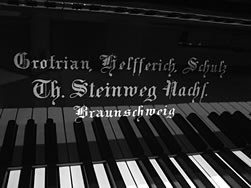
The piano was a special order by Clara Schumann, made in 1877 by Grotrian Steinweg, and it’s a concert grand with 88 keys. In November 1887, after playing with this piano in a concert in Krefeld, German, Clara Schumann donated it to the city. The piano had been used in high school music education until 1930, and was later preserved in Linn museum due to deterioration. It was kept in the museum’s basement in the World War II, thus surviving the Allied bombing. In 1984, it was sent to Krefeld’s city-run music class to get repaired, but not quite successful. In 1987, the piano was sold to a Japanese trading company and sent to Japan. After being overhauled, the piano was occasionally played in hotels, but since one year ago it had stayed in the antique warehouse.
I had a pleasant conversation with the owner of the piano, and after one hour, the owner made an incredible suggestion: “It will be a great honor for the piano if it can be played by such a virtuoso. I would like to hand it over to you, so that you can overhaul it as you wish.” the owner said. Thus Clara Schumann’s piano came under my possession before I had a chance to watch it. Honestly I was a little bit worried about the piano’s condition, but I knew very skillful piano tuners who spent one year to overhaul my Steinway which had supported Ms. Slenczynska until the last concert, so I felt quite optimistic.
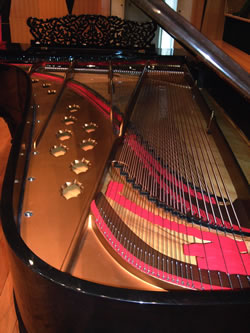
A week later, the piano was sent from Tokyo to the tuner’s studio in Osaka. Its decorated feet and pedals were reminiscent of 19th century Romantic style, and its grace was suitable to Clara Schumann. However, the overall condition of the piano was quite miserable. The seven tuners quickly opened the piano and made a thorough inspection, and they made this conclusion: “This piano may not be overhauled.” The reason was that the previous repairs had actually been harmful to the piano, and the repaired parts were replaced with modern ones. Everyone found it almost impossible to recover the original touch and sound of the piano.
My fear proved right.
However, when I returned to Okayama depressed, an unexpected discovery changed the whole situation: I went to a bookstore the following day, and on a book which I picked up carelessly, I found that one of Clara Schumann’s piano was kept in the musical instrument museum of Musashino Academia Musicae. I thought that if we could check the piano in the museum, it might be helpful in repairing my own Clara Schumann’s piano. Fortunately the curator was understanding to our project and gave us permission to examine the piano thoroughly, which was a great breakthrough for the repair work.
The Clara Schumann piano kept in Musashino Academia Musicae was a Grotrian Steinweg made in 1871, a mahogany concert grand in good condition, with 85 keys. When we opened the piano, everyone was surprised to find that the inner parts were all repaired with original ones. At that moment, I started to believe that my own piano could also be repaired to nearly the same condition as Clara Schumann had played it.
In the latter half of the 19th century, especially from 1860 to 1880, the piano underwent tremendous changes before taking on its modern form. From 1871, within only six years, the piano from the same Grotrian brand had increased its number of keys, lengths and sizes, and became almost identical to the modern Steinway piano (the word “Steinweg” in “Grotrian Steinweg” refers to Steinway. Grotrian pianos were almost always made under the patent of Steinway). However, we judged that the two pianos didn’t differ too much in a certain aspects, such as the thickness of the strings, the measure of the action, and the material of the wooden parts. So we decided to repair our piano according to the one kept by Musashino, ordering strings from France and actions from German, repainting the body and frame, and asking for Japanese specialists to renew the white keys. Through these processes, the piano of Clara Schumann at my place could finally be overhauled.
At the time when the schedule for the repair work was set, I got a phone call from someone after an interval of one year. “Can you speak to the people concerned about the project of inviting Ms. Slenczynska to play under the Daigo cherry tree?”
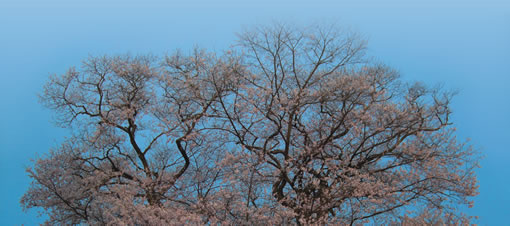
This referred to an incident that happened one year ago:
In the summer of 2005, a friend of mine came to my clinic after work to take Slenczynska’s last concert CD. When She saw the CD cover, she said: “I think I’ve seen this cherry tree before.” I told her: “This is the cherry tree on the top of a mountain in the north of Okayama. I took this picture myself and thought this 1000-year-old cherry tree was most suitable to be on the cover of Slenczynska’s last concert CD.” Then she told me: “I was born near that Daigo cherry tree.” I was surprised and told her an episode: In the spring of 2004, my family went to see the blossom of the Daigo cherry tree as we’d always done during the past 10 years. When we were appreciating the 1000-year-old cherry blossom tree for hours, my wife suddenly said: “the petals of the flowers are like each of the note Ms. Slenczynska plays.” I told these words to Slenczynska and sent her the picture of the cherry tree, and she answered: “I would like to see the cherry tree myself.” This led to Slenczynska’s third Japanese concert in the summer of 2004, and the live recording was released as “The Art of Ruth Slenczynska II & III.”
After finishing the concerts and recording sessions that lasted for two weeks in a heated room with a temperature around 35 ℃, I kept my promise and took Slenczynska to see the Daigo cherry tree. There was thunder and shower in the afternoon, but when we reached the top of the mountain, the rain suddenly stopped, so that we could appreciate the cherry tree to our hearts’ content. When we were on our way home, the wind started again, and the leaves of the cherry tree were blown onto our car. At that moment, Slenczynska murmured: “I wish I could play under this tree someday.” In the end of the episode, I added: “Of course, everyone who has ever been to the Daigo cherry tree knows that it is an impossible dream.” But my friend exclaimed enthusiastically: “No! Let’s make this dream come true!”
She immediately contacted a high-school classmate who worked in Maniwa City Office and had been in charge of the Daigo tree for years. Ms. Kiriaki, the classmate, was moved by Slenczynska’s music, personality and her love towards the cherry tree, and she was exactly the one who phoned me as I mentioned earlier. She had been trying to persuade the local people to realize this crazy idea: inviting an 81-year-old American pianist whom they’d never heard of to play the piano under the Daigo cherry tree.
Apart from the question of whether it’s possible to bring a concert grand piano atop the mountain, it was also difficult to explain why we should take such pains to play the piano under the cherry tree.
I could understand those people’s doubts, so I didn’t expect too much. However, one year later, I got the unexpected phone call from Ms Kiriaki who told me: “Everyone starts to say, ‘Hey, how can we have ignored such a great idea all this time!’ I will gather the people concerned and have a meeting. Can you come to the cherry tree?”
One week later, although I was still uncertain of success, I went there and gave a speech before more than 20 local people, on the topic of Slenczynska, how she and my family met the Daigo cherry tree, and that the recital under the cherry tree was not for the audience (Slenczynska had stopped playing in public after the last concert) but for the cherry tree―in other words, it was supposed to be a dedication recital. After talking on for nearly one hour, I looked around timidly and found that everyone who had seemed confused in the beginning started to smile with understanding. Finally, the president stood up and said: “We know nothing about music, but after hearing what you said, I believe that we should cherish this connection and realize Ms Slenczynska’s dream.”
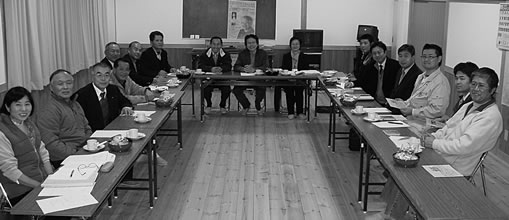
At this moment, Slenczynska’s dedication recital had finally been decided.
As for the date, we all agreed that the recital should be held during the cherry blossom season next spring.
“Then, let’s take Clara Schumann’s piano there.”
I immediately declared.
On the top of the mountain under a 1000-year-old Japanese cherry blossom tree, with the newly repaired piano of German musician Clara Schumann, plays the 82-year-old piano virtuoso Ruth Slenczynska―the three of them joining together seemed to me a picture of Utopia. However, everyone understood that in order to realize the utopia, we should overcome a series of difficulties.
Is it possible to stop the traffic, which usually takes three more hours to get to the mountain top in the cherry blossom season, for half a day in order to hold the piano recital? How should we send the piano to the mountain top safe and sound? Will the cherry tree blossom on schedule? Will the repair work of Clara Schumann’s piano complete in time before the recital? And most important of all, the project was decided without asking Slenczynska’s permission in advance. Will she come? And even if she agree to come, will she be able to stand the labor of coming to Okayama all the way from New York and fulfull such a heavy task at the age of 82? Each question was an uncertain factor, and the failure of overcoming anyone of them would spoil the whole plan.
All the labors were meant to achieve one simple goal: playing the piano for the cherry tree.
Strangely enough, from the beginning, everyone involved in this project seemed to believe that nothing is impossible when we work together. The respect for Slenczynska became the impetus that drove the technicians to repair the piano in time. Even the European dealers who are usually rigid on the date of delivery hastened the manufacture schedule of the piano parts for us. However, the most difficult part was to persuade Slenczynska herself to come to Okayama and play.
Being a perfectionist, Slenczynska knew very well that even for one recital only, she would have to resume the life of practicing 8 hours a day for at least half a year. As I had expected, although she was very excited about this plan at first and immediately made up a program containing more than 10 of Brahms and the Schumann couple’s works, when the date of her visit to Japan drew near, she started to wrote me pessimistic mails like: “I may not be able to go to Japan!” When all the other tasks were going on wheels, I had to try hard to encourage her without giving her too much pressure from the other end of the earth in Okayama.
A month before the recital, something happened that determined Slenczynska to come: a TV station in Okayama which had been planning to make a documentary of this event would like to interview Slenczynska, and I went with the staff to New York in the middle of March.
During this disastrous trip, we were first stranded at the Detroit Airport for one day and a half, and when we finally arrived in the airport at midnight in New York, the luggage including a pile of camera equipments was missing, shortening the interview schedule to merely half a day. Furthermore, on the night of arrival, my friend held a home concert to welcome us, and I was forced to go on stage without any preparation to play the cello….
In the end, we only stayed in New York for one day. The next morning on the way back to Japan, I made a phone call to Slenczynska from the airport. “Your performance last night was really impressive. I believe your musical expression is aiming the same direction as mine.” Her voice seemed cheerful and was completely different from last night. I was surprised and replied humbly: “I just learnt from your music.” Then I quickly added: “I believe your music still keeps evolving. Please leave more of your art for all the music fans.”
“All right!” Slenczynska answered loudly. Her voice was as confident as I have known for the past four years. The trip which had a worst start succeeded in motivating Slenczynska to perform again. At this moment all the human affairs had been settled. The remaining problem was to pray that the weather would be fine and the cherry would blossom on the day of recital, April 16th.
In the end of March, I made a decision which even I myself found incredible― “I had a foreboding; we should definitely put forward the date!” I told the people concerned in a nearly threatening tone: “I promise that it will be a fine day, and the cherry tree will blossom, too!” Thus the recital date was changed to April 12th.
However, the winter of 2007 was unusually warm, and the Daigo cherry tree started blossoming ten days earlier than usual on April 1st. The flowers usually fall completely within one week, so everyone involved in this project watched it with anxiety.
The change of date also had great impact on the repair work of the piano. The schedule was already tight enough, and in the final week, everyone in the studio had to work day and night to make it on time.
Slenczynska, without any knowledge of the turmoil of the staff here, came with a lively heart to Okayama on April 8th. As before, she went straight from the station to where the piano was. The finely repaired piano had just been sent back from Osaka, and it gave incredibly rich sound. “It will take me a couple of days to make friend with this piano.” Slenczynska said, and started practicing eight hours a day.
A few days later, there was a rare snow in April, which made the cherry tree remained blooming, as everyone had prayed, until the previous day of the recital. As for the weather, while the forecast one week ago predicted a 60 % chance of rain, on the day before the recital, the chance of rain had fallen to 20%. On the morning of April 12th, the sky was clear, and the Daigo cherry tree was in full bloom, without even one petal fallen under the tree.
Clara Schumann’s piano was settled on the marvelous stage which was made of the local Japanese cedar of the best quality and carefully designed to fit the slope of the mountain top.
In the early morning, Slenczynska played the piano for 30 minutes in the elementary school with only 5 students at the foot of the mountain. Then she went straight into the police car which was supposed to lead the way to the mountain top. When she arrived at the cherry tree, the image which had been in my mind since half a year ago came true. The scene before my eyes was exactly the same image used on Slenczynska’s last concert CD cover, with Slenczynska sitting before the piano under the Daigo cherry blossom, smiling satisfactorily. The only difference was that the piano wasn’t the Steinway which she used to play, but Clara Schumann’s piano.
This miracle was made true by the pure enthusiasm of those who started the project, the piano technicians, and the local people who were mostly above 70 years old. On this mountain beloved by the Japanese people, it was the first time that the western music instrument―piano―was played.
To commemorate Clara Schumann, Slenczynska chose Brahms’ “Romance” (op. 118-5), Waltz (op. 39), Hungarian Dance No. 1, Clara Schumann’s “Larghetto”, Robert Schumann’s “Romance” (op. 28-2) , “Traumerei” (celebrating Prince Hisahito’s birthday) for her program, as well as Kosaku Yamada’s “Sand Mountain,” which was dedicated to the Queen of Japan, whom she befriended when she was invited to the palace in February, 2005. The selection was like a revelation, assisted by the magical power of Daigo cherry tree, of the romantic secrets hidden in the hearts of Robert Schumann, Clara Schumann and Brahms.
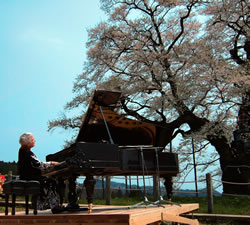
The warblers which were startled by the first notes of Brahms’ “Romance” soon started to sing along with the rhythm of the music, and in the middle of the performance, the flowers on the cherry tree began to fall. It seemed as if the Daigo cherry tree was showing its gratitude towards the music. When Slenczynska finished playing the final piece and stood up, the flowers were already falling furiously like a snowstorm.
The true beauty of Japan which deserved the name of paradise was revealed in front of everyone.
Since Slenczynska had already declared “I won’t play before the public anymore,” ropes were drawn around the piano with a radius of 30 meters to separate the performer from the local people who were listening quietly outside. However, at this moment, Slenczynska waved her hands and called upon the audience: “Come here!” Then, in the falling flowers, she played two pieces for these people who made this recital come true: Schuman’s “Widmung” and Chopin’s “Minute Waltz,” to express her gratitude.
Slenczynska’s dream of playing piano under the Daigo cherry tree was realized in an incredibly wonderful manner.
Even in the other world, we might never seen such a beautiful scene.
However, Slenczynska didn’t have time to enjoy the success of the dedication recital, because she had to go to two other elementary schools far away from the cherry tree in the city and spent more than one hour in each school playing the piano for the children. After she completed the schedule of the day, it was already five in the evening.
There was a grand farewell party held by the local people that evening. In the party, Slenczynska could finally eat the meal prepared by the local women and watch the traditional dance, ending the whole event with pure joy.
A few days later, Slenczynska left Japan on April 16th, which was the original date of the recital. On that day, there was heavy rain around the area near the Daigo cherry tree, while the flowers on the tree had already fallen off completely on the next day of the recital, without a single flower left on the tree.
The newly built stage was taken apart on the day after the recital, and Clara Schumann’s piano was returned to my house. The leaves came out on the Daigo cherry tree, and the local people were starting to prepare for the planting season. The paradise which appeared on the mountain top that day disappear without a trace during one day.
Yet the miracle did appear before those who were attracted by the Daigo cherry tree and worked together for this event. I had witnessed, in the whole process, the involvement of a number of people, who worked on their own in the beginning and later intertwined together in the right time. The incredible power of these links even affected the nature which was beyond the human control, and finally led to the best results. I could only conclude that it was indeed the work of some magical power.
May be it was the 1000-year-old cherry tree that had brought together Clara Schumann’s piano and Ruth Slenczynska, in order to give us some kind of message. Maybe it wanted to tell us, utopia isn’t an impossible dream in this world. At any rate, the truly beautiful Japan which I had witnessed would always remain in my heart.
Above I have described the whole story behind the dedication recital to the Daigo cherry tree performed by Slenczynska in April, 2007. However, although her dream of playing under the cherry tree had come true, my dream of inviting her to record the later works of Brahms remained unrealized. One reason was that the dedication recital alone demanded unexpected amount of labor, so it was impossible to ask Slenczynska for more. Another reason was that Clara Schumann’s piano, though repaired perfectly for the recital, still required more regulations and playing before it could be used for recording.
With the promise of improving the piano’s condition, I asked Slenczynska to come to Japan again in November. Furthermore, when she came to Japan in April, the chief priest of an old temple in the south of Okayama asked her to hold a dedication recital for the last day of the 99th-year exhibition of the twelve-faced Kannon made by Gyouki, and Slenczynska agreed. Thus she had one more goal to come to Japan again, and I believed this time everything would go smoothly.
However, Slenczynska soon started to write me pessimistic mails again from New York.
In fact, the most serious problem for her was not mental, but physical.
The physical decline everyone faces when over eighty especially irritated her. “I have a lot of new ideas, but I have no strength to make them take shape. It’s really a pity.” “When you reach the age of eighty, you’ll know!” I have heard her mentioning once. There was actually even more serious problem: since her late seventies, she had suffered from light rheumatism, and her hands, which were most important to a pianist, started to stiffen and shake. Even so, with incredibly hard practice, she had revealed astonishing performance in her last concert. However, in the autumn of 2005, when she was invited to the Chopin Competition, she hurt her left hand by carrying around heavy luggage on her way to Poland. She could not even hold a cup until a few months before the dedication recital, and this was the biggest reason that made her hesitate to come to Japan in 2007. The dedication recital to the Daigo cherry tree was accomplished after she had overcome all those difficulties.
What’s more, the Brahms’ works chosen for the recording this time would be a heavy burden to Slenczynska, who has small hands. All that I could do was to pray for her in Okayama.
Fortunately, through the incessant hard practice, Slenczynska came up with even more new ideas and inspirations and totally forgot the problems with her fingers. She became once again an enthusiastic pianist burning with creativity.
In November 2007, Slenczynska came for the 6th time to Okayama, and fulfilled my wish to record the CD.
At first, she played all the works with Clara Schumann’s piano following the original plan, but after practicing for several days, she found it hard to interpret Brahms’ “two rhapsodies op. 79” and “op. 118, 119” on this piano. In the end, the three pieces were recorded with the 1926-made Steinway which she used before. Thus all the works were played with the piano that suited the time of their composition, recorded separately on 2 CDs, making this recording even more significant.
However, in the summer of 2008, Slenczynska decided to re-record Brahms’ works except the waltzes, and that’s why this CD recorded with Clara Schumann’s piano is released solely.
translator Kiyoko Kruzliak
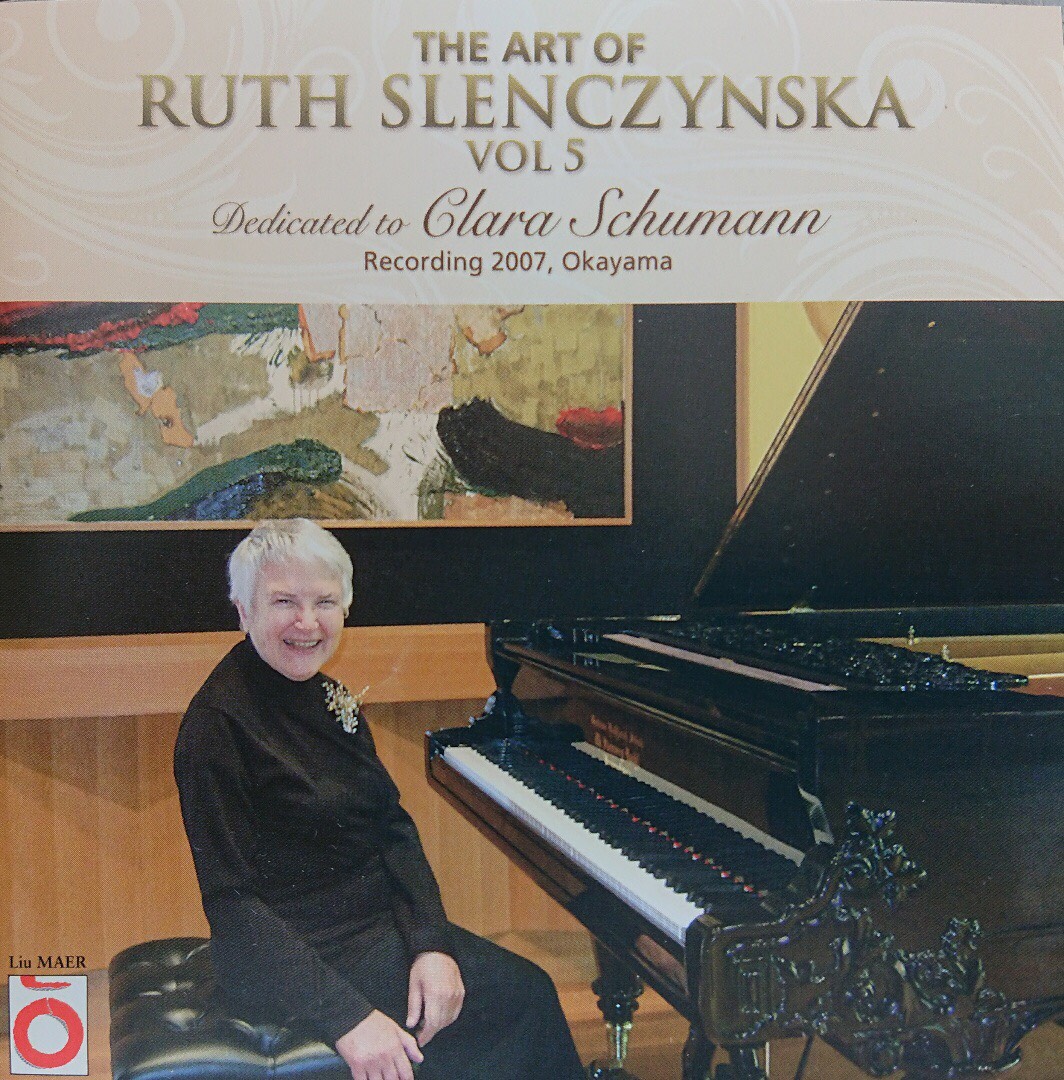
The Art of Ruth Slenczynska V
クララ・シューマンのピアノを弾く!
- Recording
- Nov.12th and 15th, 2007 Liu Mifune Art Ensemble
- Piano
- Grotrian Steinweg (1877, No.3306) in Lie Mifune Art Ensemble
- Performance
- Ruth Slenczynska (Piano)
2007年、数奇な運命を経て、日本で新しい命を与えられたクララ・シューマン愛用のグロトリアン・スタインヴェッグ(No.3306 1877年製)からルース・スレンチェンスカが呼び寄せたクララ、ロベルト・シューマンとヨハネス・ブラームスの魂の声がここに。2005年の驚異のラスト・コンサートから2年、82歳の幻の巨匠ルース・スレンチェンスカが極めたピアニズムの豊饒な楽園。
 〒703-8266 岡山県岡山市中区湊836-3
〒703-8266 岡山県岡山市中区湊836-3

